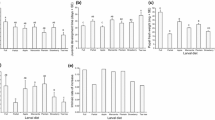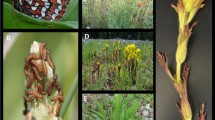Abstract
Hydrocotyle ranunculoides (Araliaceae) is an aquatic plant native to the Americas and invasive in Europe. This work reports laboratory and garden studies on the host range of its main natural enemy, the weevil Listronotus elongatus (Hustache) (Coleoptera: Curculionidae). The genus Hydrocotyle is in a disputed phylogenetic situation such that both Apiaceae and Araliaceae must be included in the test list, but lacking a clear criterion of phylogenetic proximity. For this reason three testing instances were applied: no-choice on excised leaves, no choice on functional plants, and a multiple choice garden experiment. A large initial test-plant list was reduced to a smaller list adjusted by a feeding intensity criterion, survival curves and oviposition levels. Feeding was observed on the excised leaves of 21 out of 36 test plants, but as tests progressed to whole plants L. elongatus showed it could only develop and thrive on its natural host, and possibly survive as adults on Hydrocotyle modesta. Results confirm that typical laboratory starvation tests can provide a dependable ranking of physiological acceptability of different plant species but severely overestimate the actual host range of a specialized herbivore. They also indicate that the phylogenetic criterion for test plant list construction must be approached cautiously if the phylogeny is uncertain or disputed.

Similar content being viewed by others
References
Appel HM, Martin MM (1992) Significance of metabolic load in the evolution of host specificity of Manduca sexta. Ecology 73:216–228
Baldwin IT (1999) Functional interactions in the use of direct and indirect defences in native Nicotiana plants. In: Chadwick DJ, Goode JA (eds) Insect-plant interactions and induced plant defence. Novartis Foundation Symposium 223, Wiley, Chichester, pp 74–87
Biere A, Marak HB, van Damme JMM (2004) Plant chemical defense against herbivores and pathogens: generalized defense or trade-offs? Oecologia 140:430–441
Briese DT (2003) The centrifugal phylogenetic method used to select plants forhost-specificity testing of weed biological control agents: can and should it be modernised? In: Spafford Jacob H, Briese DT (eds) Improving the selection, testing and evaluation of weed biological control agents. Proceedings of the CRC for Australian weed management biological control of weeds symposium and workshop. University of Western Australia, Perth, Western Australia, Sept 2002, pp 25–33
Briese DT (2005) Translating host-specificity test results into the real world: the need to harmonize the yin and yang of current testing procedures. Biol Control 35:208–214
Briese DT, Zapater M, Andorno A, Perez Camargo G (2002) A two-phase open-field test to evaluate the host-specificity of candidate biological control agents for Heliotropium amplexicaule. Biol Control 25:259–272
Cabrera Walsh G, Weber DC, Mattioli F, Heck G (2008) Qualitative and quantitative responses of Diabroticina (Coleoptera: Chrysomelidae) to cucurbit extracts linked to species, sex, weather and deployment method. J Appl Entomol 132:205–215
Cabrera Walsh G, Maestro M, Dalto YM, Shaw R, Seier M, Cortat G, Djeddour D (2013) Persistence of floating pennywort patches (Hydrocotyle ranunculoides, Araliaceae) in a canal in its native temperate range: effect of its natural enemies. Aquat Bot 110:78–83
Cabrera Walsh G, Maestro M, Sosa A, Tipping PW (2014) Specificity of Lepidelphax pistiae (Hemiptera: Delphacidae) to Pistia stratiotes (Araceae). Biocontrol Sci Technol 24:485–488
Cordo HA, DeLoach CJ, Ferrer R (1982) The weevils Lixellus, Tanysphiroideus and Cyrtobagous that feed on Hydrocotyle and Salvinia in Argentina. Col Bull 36:279–286
Cruttwell McFadyen RE (1998) Biological control of weeds. Annu Rev Entomol 43:369–393
Gamerro JC, Zuloaga FO (1998) Dendropanax affinis, nueva combinación y sinopsis de las Araliaceae argentinas. Darwiniana 35:163–166
Heard TA, van Klinken RD (1998) An analysis of designs for host range tests of insects for biological control of weeds. In: Zalucki MP, Drew RAI, White GG (eds) Pest management—future challenges, sixth Australasian applied entomology research conference, vol 7. The University of Queensland Printery, Brisbane, pp 539–546
Hinz HL, Schwarzlander M, Gaskin JF (2008) Does phylogeny explain the host-choice behaviour of potential biological control agents for Brassicaceae weeds? In: Julien M, Sforza R, Bon MC, Evans HC, Hatcher PE, Hinz HL, Rector BG (eds) International symposium on biological control of weeds. CABI North American Office, Cambridge, pp 418–425
Hinz HL, Schwarzländer M, Gassmann A, Bourchier RS (2014) Successes we may not have had: a retrospective analysis of selected weed biological control agents in the United States. Invasive Plant Sci Manag 7:565–579
Howe GA, Schaller A (2008) Chapter 1. Direct defenses in plants and their induction by wounding and insect herbivores. In: Schaller A (ed) Induced plant resistance to herbivory. Springer, New York, pp 7–29
IBM SPSS Statistics for Windows, Version 19.0. Released 2010. IBM Corp, Armonk, USA
Kehat M, Gordon D (1975) Mating, longevity, fertility and fecundity of the cotton leaf-worm, Spodoptera littoralis (Boisd.) (Lepidoptera: Noctuidae). Phytoparasitica 3:87–102
Konstantinova AI, Yembaturova EY (2010) Structural traits of some species of Hydrocotyle (Araliaceae) and their significance for constructing the generic system. Plant Div Evol 128:329–346
Liu M, Plunkett GM, van Wyk BE, Tilney PM, Lowry PP (2012) The phylogenetic significance of the carpophore in Apiaceae. Ann Bot 110:1531–1543
Lowry PP, Plunkett GM, Oskolski AA (2001) Early lineages in Apiales: insights from morphology, wood anatomy and molecular data. Edinb J Bot 58:207–220
Lowry PP, Plunkett GM, Wen J (2004) Generic relationships in Araliaceae: looking into the crystal ball. S Afr J Bot 70:382–392
Marohasy J (1996) Host shifts in biological weed control, real problems, semantic difficulties or poor science? Int J Pest Manag 42:71–75
Nicolas AN, Plunkett GM (2009) The demise of subfamily Hydrocotyloideae (Apiaceae) and the re-alignment of its genera across the entire order Apiales. Mol Phylogenet Evol 53:134–151
Nishida R, Fukami H (1990) Sequestration of distasteful compounds by some pharmacophagous insects. J Chem Ecol 16:151–164
Olckers T, Hulley PE (1994) Host specificity tests on leaf-feeding insects: aberrations from the use of excised leaves. Afr Entomol 2:68–70
Palmer WA (1999) The use of cut foliage instead of whole plants for host specificity testing of weed biocontrol insects—is this acceptable practice? In: Withers TM, Baton Browne L, Stanley J (eds) Host specificity testing in Australasia: towards improved assays for biological control. CRC for Tropical Pest Management, Brisbane, pp 20–29
Pedersen TM (2005) Orden XXXIX Umbeliflorales. In. Burkart A, Bacigalupo NM (eds) Flora Ilustrada de Entre Ríos –Argentina, Parte IV, Dicotiledóneas Arquiclamídeas B: Geraniales a Umbelliflorales. Colección Científica del I.N.T.A., tomo VI, IV, Buenos Aires
Plunkett GM, Chandler GT, Lowry PP, Pinney SM, Sprenkle TS (2004) Recent advances in understanding Apiales and a revised classification. S Afr J Bot 70:371–381
Rasmann S, Agrawal AA (2008) In defense of roots: a research agenda for studying plant resistance to belowground herbivory. Plant Physiol 146:875–880
Ruiz-Avila RJ, Klemm VV (1996) Management of Hydrocotyle ranunculoides L.f., an aquatic invasive weed of urban waterways in Western Australia. Hydrobiol 340:187–190
Schmelz EA, Alborn HT, Tumlinson JH (2001) The influence of intact-plant and excised-leaf bioassay designs on volicitin- and jasmonic acid-induced sesquiterpene volatile release in Zea mays. Planta 214:171–179
Sheppard AW, van Klinken RD, Heard TA (2005) Scientific advances in the analysis of direct risks of weed biological control agents to nontarget plants. Biol Control 35:215–226
Sheppard AW, Shaw RH, Sforza R (2006) Top 20 environmental weeds for classical biological control in Europe: a review of opportunities, regulations and other barriers to adoption. Weed Res 46:93–117
SYSTAT Software, Inc. (2004) SYSTAT 11. Richmond, USA
Wapshere AJ (1974) A strategy for evaluating the safety of organisms for biological weed control. Ann Appl Biol 77:201–211
Acknowledgements
We wish to thank Juan José Valla and Pablo Pica for several of the plant identifications, three anonymous referees and two editors of the journal for many, many important pieces of advice, and Octavio Bruzzone for statistical help. CABI-Europe financed most of the studies through a Cooperative Agreement of April 2012. Collecting permits to initiate the laboratory colonies were obtained from the DGRN of the Production Ministry of the Province of Entre Ríos, Argentina.
Author information
Authors and Affiliations
Corresponding author
Additional information
Handling Editor: S. Raghu.
Rights and permissions
About this article
Cite this article
Cabrera Walsh, G., Maestro, M. Assessing the specificity of a herbivore on a plant of uncertain phylogenetic placing: Listronotus elongatus a herbivore of Hydrocotyle ranunculoides . BioControl 62, 269–279 (2017). https://doi.org/10.1007/s10526-017-9785-0
Received:
Accepted:
Published:
Issue Date:
DOI: https://doi.org/10.1007/s10526-017-9785-0




